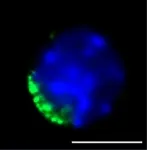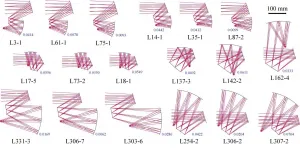Abandoning the old ways: Progress in the low-cost electrochemical synthesis of ammonia
Scientists develop high performing electrocatalyst to synthesize ammonia in an effort to replace conventional eco-unfriendly methods
2021-04-13
(Press-News.org) Ammonia (NH3) is among the most important chemicals produced by humans and has a promising future in sustainable energy applications besides being used in fertilizer production. Unfortunately, so far, the only realistic way that exists to produce ammonia at an industrial scale is through the Haber-Bosch process. This technique, discovered in the 19th century, is very energy-intensive and environmentally unfriendly; about 2% of the yearly global CO2 emissions come from Haber-Bosch processes.
"Considering the threats posed by global warming, it is high time we swap to an ammonia synthesis route with zero CO2 emissions," says Professor Sangaraju Shanmugam from Daegu Gyeongbuk Institute of Science and Technology (DGIST), Korea. Shanmugam and colleagues at DGIST have been working on finding new ways to produce ammonia through electrochemical reactions at room temperature using the nitrogen (N2) naturally present in air, a process technically known as 'electrocatalytic fixation of atmospheric N2.'
Although various research groups have successfully developed catalysts for electrochemical cells with high ammonia production rates, many suffer from low efficiency and selectivity towards N2. Others require precious metals or complex synthesis processes, which limits their applicability on an industrial scale. In a recent study published in Applied Catalysis B: Environmental, DGIST scientists led by Prof. Shanmugam tackled all these issues with a novel catalyst for electrochemical ammonia synthesis.
Their approach is based on molybdenum nitride (Mo2N) nanoparticles, which share electrical properties with the enzyme nitrogenase that some bacteria use to produce ammonia in nature. Nanoparticles alone don't make the cut; however, because they tend to stick to each other, this agglomeration reduces the total surface area that is exposed to N2 and thus hinders the catalyst's performance. To combat this problem, the scientists produced two-dimensional hexagonal boron nitride (h-BN) sheets and tailored them to contain defects. These defects--boron and nitrogen vacancies--provided sites for the Mo2N nanoparticles to anchor themselves without agglomerating much.
With this catalyst, the team managed to synthesize ammonia at a high rate with an efficiency of 61.5% in a stable and robust way. Most notably, the entire fabrication process of the low-cost ?-Mo2N/h-BN catalyst can be done in a single step, which makes it an attractive option in terms of industrial scalability. Furthermore, the study provided important insight into how the size of the nanoparticles affects the selectivity of the catalyst for nitrogen fixation. Prof. Shanmugam observes: "We believe our work will greatly contribute to the development of efficient catalysts. Advancing alternative technologies for the production of valuable chemicals like ammonia via electrocatalytic methods shall pave the way for a cleaner and safer environment."
Hopefully, further studies will finally allow us to abandon the methods of yesterday in favor of the sustainable alternatives of tomorrow.
INFORMATION:
Reference
Authors: David Kumar Yesudoss , Gayoung Lee , Sangaraju Shanmugam*
Title of original paper: Strong catalyst support interactions in defect-rich γ-Mo2N nanoparticles loaded 2D-h-BN hybrid for highly selective nitrogen reduction reaction
Journal: Applied Catalysis B: Environmental
DOI: 10.1016/j.apcatb.2021.119952
Affiliation: Department of Energy Science & Engineering, Daegu Gyeongbuk Institute of Science & Technology (DGIST)
*Corresponding author's email: sangarajus@dgist.ac.kr
About Daegu Gyeongbuk Institute of Science and Technology (DGIST)
Daegu Gyeongbuk Institute of Science and Technology (DGIST) is a well-known and respected research institute located in Daegu, Republic of Korea. Established in 2004 by the Korean Government, the main aim of DGIST is to promote national science and technology, as well as to boost the local economy.
With a vision of "Changing the world through convergence", DGIST has undertaken a wide range of research in various fields of science and technology. DGIST has embraced a multidisciplinary approach to research and undertaken intensive studies in some of today's most vital fields. DGIST also has state-of-the-art-infrastructure to enable cutting-edge research in materials science, robotics, cognitive sciences, and communication engineering.
Website: https://www.dgist.ac.kr/en/html/sub01/010204.html
About the authors
Prof. Sangaraju Shanmugam did his PhD on heterogenous catalysis from Indian Institute of Technology, Madras, India in 2004. He then worked as a postdoctoral fellow in 2005 in Bar-Ilan University and as a JSPS postdoctoral fellow at Waseda University in 2007. In 2011, he was appointed as an Assistant Professor at DGIST, Korea, where he serves as a Professor now. Shanmugam currently has 130 refereed publications to his credit, 5 Indian Patents and has filed 8 Korean patents. Prof. Shanmugam's current research interests include development of cost-effective, durable electrode materials for polymer electrolyte membrane fuel cells and their applications towards energy conversion and storage, biosensors, and biomedical applications.
[Attachments] See images for this press release:

ELSE PRESS RELEASES FROM THIS DATE:
2021-04-13
What started out as a second-year physics project is making its way into Amazon Web Service's (AWS) quantum computing program.
University of Sydney science undergraduate Pablo Bonilla Ataides has tweaked some computing code to effectively double its capacity to correct errors in the quantum machines being designed in the emerging technology sector.
The simple but ingenious change to quantum error correcting code has grabbed the attention of quantum researchers at the AWS Center for Quantum Computing in Pasadena, California, and the quantum technology programs at Yale University and Duke University in the United States.
"Quantum technology is in its infancy, partly because we haven't ...
2021-04-13
CORVALLIS, Ore. - A new study by Oregon State University researchers found that shade provided by solar panels increased the abundance of flowers under the panels and delayed the timing of their bloom, both findings that could aid the agricultural community.
The study, believed to be the first that looked at the impact of solar panels on flowering plants and insects, has important implications for solar developers who manage the land under solar panels, as well as agriculture and pollinator health advocates who are seeking land for pollinator habitat restoration.
The findings, ...
2021-04-13
Durham, NC - When leukemia strikes an older person, it is in part due to the aging of his or her hematopoietic stem cells (HSCs). These immature cells can develop into all types of blood cells, including white blood cells, red blood cells and platelets. As such, researchers have focused on rejuvenating HSCs as a way to treat leukemia.
A new study released today in STEM CELLS adds much to that level of knowledge by showing that the youthful function of rejuvenated HSCs upon transplantation depends in part on a young bone marrow "niche," which is the microenvironment surrounding stem cells that interacts with them to regulate their fate.
"The information revealed by our study tells us that the influence of this niche ...
2021-04-13
Ancient clues, in the shape of fossils and archaeological evidence of varying quality scattered across Australia, have formed the basis of several hypotheses about the fate of megafauna that vanished about 42,000 years ago from the ancient continent of Sahul, comprising mainland Australia, Tasmania, New Guinea and neighbouring islands.
There is a growing consensus that multiple factors were at play, including climate change, the impact of people on the environment, and access to freshwater sources.
Now, research led by Professor Corey Bradshaw of Flinders University and the Australian Research Council Centre of Excellence of Australian Biodiversity and Heritage (CABAH) has used sophisticated mathematical modelling to assess how susceptible different species were to extinction - and what ...
2021-04-13
April 13th, 2021, Washington, D.C. - The severe health and economic impacts of the COVID-19 pandemic have disrupted food systems and upended livelihoods. Yet pandemic responses have demonstrated the power of well-crafted policies to blunt the impact of major shocks while laying the groundwork for stronger, more resilient food systems, according to the 2021 Global Food Policy Report, released today by the International Food Policy Research Institute (IFPRI). The report provides lessons drawn from the current crisis that can help us transform food systems to reduce the impact of the ongoing pandemic, better prepare for future shocks, and address longstanding weaknesses and inequalities.
"We have known ...
2021-04-13
In the early time of optical design, people have to be proficient in aberration theory and perform a huge amount of numerical calculations, and thus mathematical skills and talents are very important. The emergence of electronic computers has freed people from heavy calculation tasks, and realized fast real ray tracing and been able to solve complex aberration equations. Since then, the application and development of optimization algorithms and optical design software have greatly improved the speed and effect of optical design. However, optical design still requires to solve or find an initial solution as the starting point of optimization, which will greatly determine the final result of optimization. Moreover, optimization is essentially ...
2021-04-13
The top priority in the field of transplantation is to ensure that donor organs are allocated to the patients with the greatest need.
In a large-scale joint international project conducted by the Medical University of Vienna and the Mayo Clinic in Rochester (USA), researchers from the Department of General Surgery and the Division of Gastroenterology and Hepatology of MedUni Vienna's Department of Medicine III, have made a significant step forward to improve prediction of survival on the waiting list for liver transplantation by including additional laboratory parameters.
Donor ...
2021-04-13
In recent years the boom in streaming platforms and video on demand services has led to disruption in audiences, representing a difficulty when measuring the number of viewers of the content distributed by these platforms.
This new situation has not only altered the traditional television and film viewing model, but also has impacted the advertising market, which is a fundamental factor in funding and the business of audiovisual entertainment.
In this context, real and objective audience measurement (which is not influenced by the interests of the platforms) has become a key objective; it is fundamental to obtain real-time data on the reach of each production ...
2021-04-13
When trees die during a period of drought, they die of thirst. Researchers from the University of Basel have demonstrated in a field study that a rapid collapse in the hydraulic system is responsible for tree death. And they found out that the trees possibly die more rapidly than previously thought.
The heatwave of summer 2018 was an exceptional situation - both for nature and for research. Although admittedly hard on our native woods, it also presented an opportunity for researchers at the University of Basel to closely study the reaction of trees to this weather phenomenon.
The research group led by Professor Ansgar Kahmen had already set up a research area in the Basel-Landschaft municipality of Hölstein the previous year. Their aim was to study the tree ...
2021-04-13
Misinformation in public debates about scientific issues such as vaccinations and climate change can be found all over the internet, especially on social media. In a new study, Sara K. Yeo, associate professor of communication at the University of Utah, examines why it's so difficult to detect science misinformation and suggests that using humor may help combat the issue.
In the article, published in Proceedings of National Academics of Sciences, Yeo and her colleague Meaghan McKasy, assistant professor of communication at Utah Valley University, argue that limited science and media literacy combined with structural constraints such as fewer ...
LAST 30 PRESS RELEASES:
[Press-News.org] Abandoning the old ways: Progress in the low-cost electrochemical synthesis of ammonia
Scientists develop high performing electrocatalyst to synthesize ammonia in an effort to replace conventional eco-unfriendly methods





